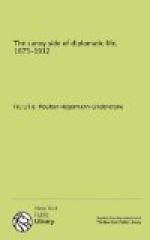“Hamlet’s grave at Helsingoer is an interesting bit of imagination. A unique instance of inaccuracy on the part of the Danes! Hamlet lived to be king in his little land and was buried where he died—if he ever lived—as an Irishman would say.”
“How confusing you are,” said my opponent. “You destroy my dearest illusions—I, who adore Shakespeare’s Hamlet.”
“I adore Shakespeare’s Hamlet, too, but I do not adore Saxo’s. Hamlet’s love for his father was the only redeeming point about him. Did you know that he married the daughter of the King of England?”
“Shakespeare only mentions Ophelia, and we are led to believe that Hamlet died unmarried.”
“Well,” I answered, “if Saxo is right, he was married, had lots of children, and continued the dynasty till dato.”
“Go on! You interest me.”
“He made himself very disagreeable at home with his silly talk and his hatred of the King and the Queen. In a conversation he had with his mother he flung away all disguise and also hurled some unpleasant and extremely unvarnished truths full in the maternal face.”
“That does not speak well for him,” said Mr. de W.
“To get rid of him,” I continued, warming to my subject, “the Danish court sent him to the English court with a nice letter of introduction, and at the same time sent a letter to the King of England, begging him to have Hamlet killed somehow or other, but clever Hamlet stole and read the letter and killed the messenger himself.”
“That shows he was no fool,” acknowledged M. de W.
“The King of England gave him a fine dinner, and I think the English court must have opened its eyes when Hamlet pushed away the food, saying it was ‘too bad to eat.’ He told them that the bread tasted of dead men’s bones and the wine of blood, and, worst of all, that the Queen was not a born lady. When the court asked with one voice how he dared breathe such an insult he answered that there were three things that proved that what he said was true.”
“It would amuse me to know what the three things were,” said M. de W.
“One was,” I said, “that the Queen held up her dress while walking; another, that she threw a shawl over her head; and the last, that she picked her teeth and chewed the contents! I actually blush for the Danes when I read the account of that dinner.”
“I confess,” laughed de W., “that that was pretty bad. Tell me some more.”
“The courtiers hurried to examine into affairs and found that everything that Hamlet said was true. The poor Queen was horribly mortified, for they discovered that her papa had been a peasant.”
“I suppose,” said M. de W., “that the court forbade the banns after that.”
“No,” I said, “Hamlet went home with his bride, and the royal Danish court of Jutland made an enormous feast for the home-coming of the princely couple. This was the thing that Hamlet had waited for all his life. Saxo hurries over this harrowing episode. Hamlet succeeded in getting all the guests dead drunk, then he pulled the tapestries all down on top of them and set fire to the palace and burned them all up. What do you think of your adorable Hamlet now?”




